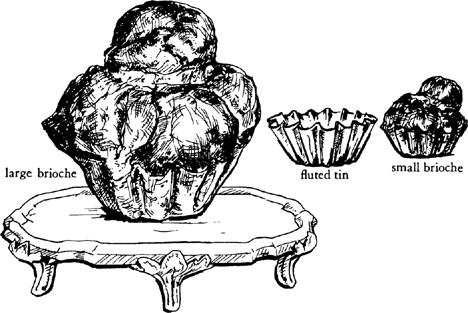Mastering the Art of French Cooking, Volume 2 (38 page)
Read Mastering the Art of French Cooking, Volume 2 Online
Authors: Julia Child

Pain Brioché—Brioche Commune—Pain Louis XV
[Egg Bread—to serve with butter and jam, for fancy sandwiches such as mousse of
foie gras
, for toast; an alternate to
brioche
dough for
Koulibiac
, sausage in
brioche
, and their like]
This is a lovely light-textured yellow bread. With another egg and three times the butter it would be a true
brioche
. Although you will find this dough quite a bit stickier and softer to handle than
pain de mie
, the technique for making it is the same.
For about 1 pound of flour, making 4 cups of unrisen dough, to fill two 6-cup covered pans, two 4-cup open pans, or for 2 dozen individual rolls formed in small molds or muffin tins
1)
Mixing and kneading the dough—either by hand or machine
1 package (0.6 ounce) fresh yeast or 1 package dry-active yeast
¼ cup warm water in a measure
1 Tb salt
2 Tb sugar
¼ cup tepid milk
3½ cups (about 1 lb.) all-purpose flour (measure by scooping dry-measure cups into flour and sweeping off excess)
A 4- to 5-quart mixing bowl with fairly straight rather than outward-slanting sides
4 eggs (U.S. graded “large”; if chilled, set for 5 minutes in warm water)
Sprinklings of flour as needed
1 stick (4 ounces) chilled butter
Sprinkle yeast in warm water and let liquefy completely. Then stir in the salt, sugar, and milk. Measure the flour into the mixing bowl, make a well in the center, add the eggs and the yeast mixture. Cut and mix everything together with a rubber spatula to form a dough. Turn out onto kneading surface and let dough rest for 2 to 3 minutes. Following illustrated directions for
pain de mie
, knead by lifting, folding, slapping, and pushing with the heel of your hand. Dough will be stickier than that for
pain de mie;
if it remains unusually so, knead in a tablespoon or so more flour. When dough begins to clean itself off kneading surface, start working in the butter by tablespoon bits. When butter is absorbed, let dough rest for 2 to 3 minutes. Knead again briefly until dough cleans butter off kneading surface and off your hands.
Or mix and knead the dough in a food processor, following directions for
pain de mie
.
2)
Completing the bread
Follow Steps 5, 6, and 7 in the Master Recipe for the first and second risings in a covered bowl and the final rise in the bread pan. Follow Step 8 for baking, except preheated oven should be at 400 degrees and baking time will be about 35 minutes. The surrounding crust will be a little darker than for
pain de mie. Pain brioché
may be eaten warm or cold, although it will slice more easily after 24 hours. It freezes perfectly.
Pain Brioché aux Raisins
[Egg Bread with Raisins]
Pain brioché
makes heavenly raisin bread, eaten plain with butter, or toasted. Follow directions for
pain de mie aux raisins
.
BRIOCHES
Although the wonderfully buttery, light, and thoroughly delectable texture of fresh
brioches
may persuade you they are manna from another planet,
brioche
dough differs from
pain de mie
dough only in that eggs are used rather than milk, and a very much larger proportion of butter is incorporated. Actually, you can use equal amounts of butter and flour, but we think the proportions of 3 parts butter to 4 parts flour make a much more manageable dough with a delicious texture and taste.
In France,
brioches
are served for breakfast with butter and jam, or for tea, or with the coffee break. Stale
brioche
may be sliced and toasted, or hollowed out and used as a container for sauced foods or appetizers.
NOTE
: The following recipe is for the classic hand-made
brioche
dough. For making it in the electric food processor, follow the general directions for
pain de mie
, first dissolving the yeast, then mixing it with the eggs, before blending the butter and flour in the processor with the salt and sugar. Blend in ¾ of the liquid, then add the rest by dribbles until the dough balls up on the blade. Finish kneading briefly by hand, as described at the end of Step 4.
 PÂTE À BRIOCHE FINE
PÂTE À BRIOCHE FINE
[
Brioche
Dough—for all sizes and shapes of
brioches
, and for
Koulibiac
, sausage in
brioche
, and their like]
You must allow a minimum 8½ hours from the time you start
brioche
dough to the time it is ready for the oven. Five hours are needed for the first rise, 2 for the second, half an hour for chilling, and 1 to 1½ hours for the final pre-bake rise. You may find it convenient to start the first rise in the late afternoon and complete the second one overnight in the refrigerator; you can then form and bake the
brioche
in the morning. However, as you will see from the delayed-action notes in the recipe, you can pretty well make it suit whatever schedule you wish.



